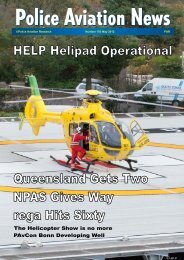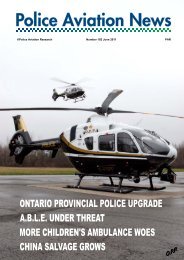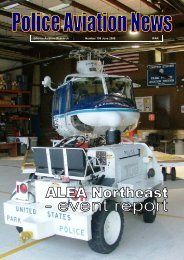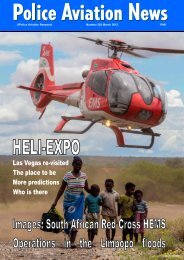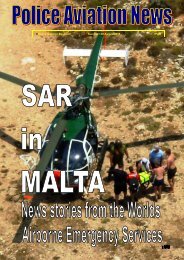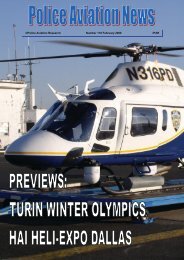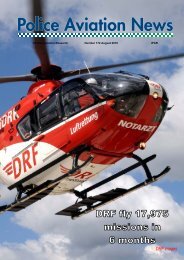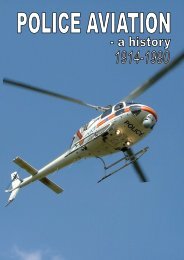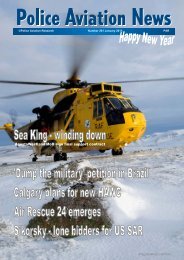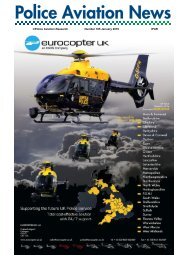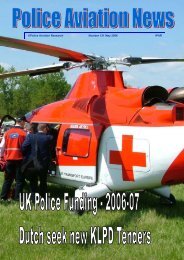Police Aviation News January 2011
Police Aviation News January 2011
Police Aviation News January 2011
Create successful ePaper yourself
Turn your PDF publications into a flip-book with our unique Google optimized e-Paper software.
<strong>Police</strong> <strong>Aviation</strong> <strong>News</strong> <strong>January</strong> <strong>2011</strong> 30<br />
GUEST FEATURE—SST<br />
Anatomy of a Ditching: Cormorant 914 July 13, 2006 Nova Scotia, Canada<br />
TUSKER 914 was a CH149 Cormorant Search and Rescue helicopter with seven crew<br />
members that was authorised to conduct a night training mission from 14 Wing Greenwood.<br />
The crew contacted the fishing vessel Four Sisters No. 1 in preparation for a practice night<br />
boat hoist. As the helicopter was approaching the vessel the Aircraft Captain, seated in the<br />
jump seat, became concerned with the helicopter’s decreasing altitude and directed the flying<br />
pilot, who was in the right seat, to go-around. During the attempted go-around the helicopter<br />
contacted the water at 69 knots calibrated air speed while in a nose-low attitude.<br />
Upon water impact the forward fuselage area was completely destroyed and the rear cabin<br />
area immediately filled with water.<br />
The impact with the water came without warning. This was of particular importance to aircrew<br />
standing in the cabin, unsupported, and attached to overhead hard points.<br />
The semi-intact fuselage quickly overturned due to the inherent high centre of gravity. Aircrew<br />
had to cope with their injuries, the in-rushing water, cold shock, reduced breath hold,<br />
severe disorientation cause by immersion and inversion in the darkness.<br />
Therefore, to successfully leave the helicopter, crewmembers in the cabin had to: find a<br />
physical reference point in the dark; orient themselves to the situation; disconnect or remove<br />
their harnesses and/or anchor straps.<br />
Following this they would: find an unblocked emergency escape exit/window; activate the<br />
escape exit jettison mechanism; clear the exit; pull themselves through the exit and clear of<br />
the aircraft; inflate their lifevests and make their way to the surface.<br />
Aftermath: Cormorant 914 Survivor Quotes<br />
Pilot: If it wasn’t for the training, I’d be done within the first 5 seconds of being in the water.<br />
Pilot: This impact was totally without warning and I immediately reacted as per the training received from the instructors at<br />
Survival Systems (Training) in Halifax. The skills they provided me were without a doubt what saved my life. Luckily I suffered<br />
only minor injuries (four broken ribs), which allowed me the chance to use those skills to free myself from the helicopter and<br />
make my way to the surface.<br />
SAR TECH: In my opinion, without the egress (RUET) training, a course I have attended several times, there is no way I'd be<br />
here today. The important steps to egress were hard-wired instinctive movements that, without prior exposure in a training<br />
element, would not have occurred.<br />
Aircraft Ditching Training<br />
Survival Systems Training Canada (SST) has been conducting<br />
Helicopter Underwater Escape Training for Military<br />
and Civilian aircrews since the mid 1980’s. Starting as a<br />
small business with a handful of employees, SST has<br />
grown and now contributes to high end training globally.<br />
Using SSL designed and built state of the art Modular<br />
Egress Training Simulator (METS TM ), and a high tech Simulation<br />
Theatre, SST can provide training unparallel in the<br />
training industry.<br />
These programmes are designed to provide operational<br />
aircrew travelling over water the knowledge and skills necessary<br />
to react to an in-flight emergency, make a plan, and<br />
prepare and survive the ditching.<br />
The standard course can range from a half day, to a full two<br />
(2) days. The newest information and techniques are covered:<br />
Hazards of operational flight over water<br />
Cold water immersion and swimming failure<br />
Safety and Survival equipment<br />
Pre-ditching considerations and procedures<br />
Emergency ditching and abandonment procedures<br />
Performance under stress<br />
Emergency Breathing Systems (EBS)<br />
This all comes together in aircraft specific METS TM configu-



